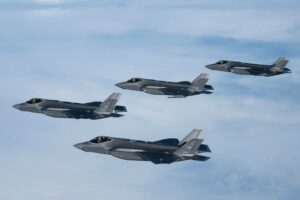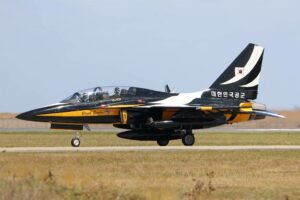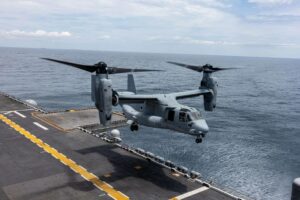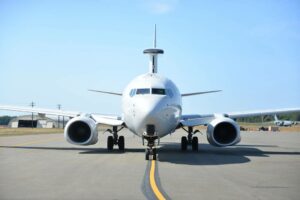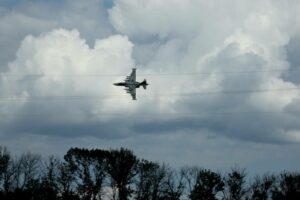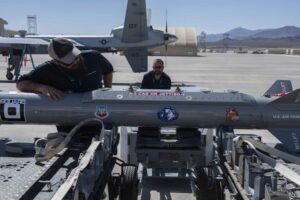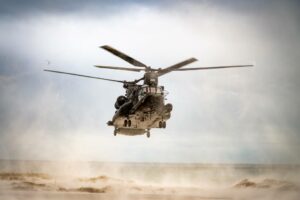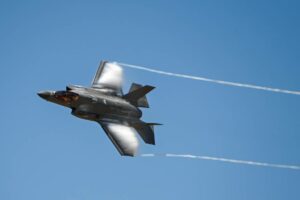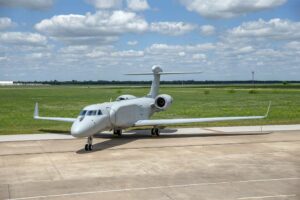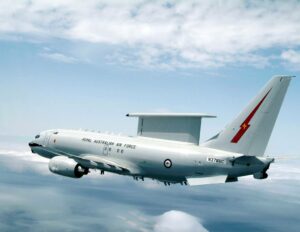DOVER AIR FORCE BASE, Del. — The hangar was relatively empty. Not even the Lockheed Martin C-5, some 250 feet long and 65 feet high, filled the space outright.
No maintainers milled about, no drills whirred and no hammers clanged. But the steady hum of spinning blades echoed through the chamber at Dover Air Force Base in Delaware, as a drone autonomously maneuvered around the transport aircraft.
Its movement, aided by digital models and crash-avoidance capabilities, was punctuated by occasional hovering as it stabilized to capture with a high-resolution camera photos of the plane’s exterior. The images then flashed onto a nearby display, with potential issues organized for expert review.
“This is what young technicians live in the Department of Defense, the Navy, the Army, the Air Force, the Marine Corps, whoever it may be,” Scott Belanger, a Boeing executive, told reporters gathered at the base Jan. 23. “This is their environment, where they are charged with generating aircraft, like the C-5 here, that are old and hard to keep on the flight line.”
RELATED
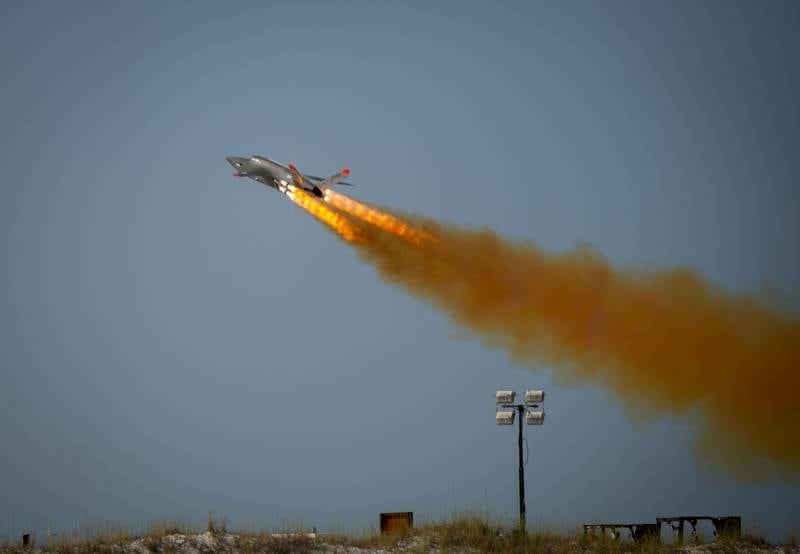
Last week marked the first time Boeing and small-business partner Near Earth Autonomy cataloged a C-5 for their Autonomous Aircraft Inspection project. By feeding photos snapped by an unmanned aerial system through automated damage-detecting software and then uploading the results into a secure database accessible across the world, the two companies hope to slash the time it takes to evaluate and repair aircraft, ultimately boosting Air Force readiness.
While Boeing and Near Earth Autonomy have worked together for months previously, assessing and digitally archiving the status of Boeing C-17 cargo planes at Joint Base Pearl Harbor-Hickam in Hawaii, the work on the East Coast marks “a big moment” for the AAI initiative, according to Belanger.
Not only did it push Boeing outside its own portfolio — handling an aircraft made by competitor Lockheed — but the work itself was executed in conditions unlike Hawaii.
“You just can’t do this stuff in a simulated environment. You’ve got to have an airplane, got to have a hanger, … got to get a little bit dirty and dive in to effectively do this,” Belanger said. “There are very few hangers in the United States where you can park a C-5 inside. There just aren’t many of these.”
Dover Air Force Base is home to both C-17 and C-5 aircraft. Traditional inspections relying on trained crews can take hours, with harnessing and clambering required. (A ladder in the tail of a C-5 brings airmen to a six-story perch.) The 34-point review conducted Jan. 23 via drone took roughly 10 minutes.
Looking ahead
As the Defense Department prepares for potential fights in the Indo-Pacific and Europe, the Air Force is pursuing what’s known as Agile Combat Employment. The ACE concept envisions a hub-and-spoke layout of bases — some larger and fixed, some smaller and mobile — that will scatter supplies, manpower and knowhow.
Only two people are needed to run the Automated Aircraft Inspection, and training takes a few hours. The process helps overcome the tedium associated with conventional assay, according to Ken Jones, an Air Force maintenance official.
“This is best, because what we have to do with our system is actually go out and then review the imagery and look for things,” he told reporters. “Their artificial intelligence is drawing little boxes around the things that the computer thinks, ‘This isn’t what it’s supposed to be.’”
The drone-and-software combo deployed at Dover Air Force Base discovered missing paint, chips and other possible irregularities. Reporters observed the review process, in which experts quickly sorted the images and flagged what needed fixing.
RELATED

“It’s pretty easy to be able to do that,” Jones said. “If you’re working over a year’s time, we could be talking about saving a week or two, and, on top of that, is the safety thing. We’re definitely interested in the time, and we’re definitely interested in the quality of the product of the inspection.”
For future examinations, Boeing and Near Earth Autonomy are eyeing additional drone payloads, to potentially catch subsurface damage, and are moving the drone outdoors, requiring weatherization upgrades to the hardware. Boeing, the fifth largest contractor in the world when ranked by defense-related revenue, committed to getting the UAS operating outside within the next year and a half.
Additional aircraft could also join the inspection roster. Near-term candidates include the KC-135 and KC-46 tankers. Both are made by Boeing.
Colin Demarest is a reporter at C4ISRNET, where he covers military networks, cyber and IT. Colin previously covered the Department of Energy and its National Nuclear Security Administration — namely Cold War cleanup and nuclear weapons development — for a daily newspaper in South Carolina. Colin is also an award-winning photographer.
- SEO Powered Content & PR Distribution. Get Amplified Today.
- PlatoData.Network Vertical Generative Ai. Empower Yourself. Access Here.
- PlatoAiStream. Web3 Intelligence. Knowledge Amplified. Access Here.
- PlatoESG. Carbon, CleanTech, Energy, Environment, Solar, Waste Management. Access Here.
- PlatoHealth. Biotech and Clinical Trials Intelligence. Access Here.
- Source: https://www.defensenews.com/unmanned/2024/01/29/boeing-expands-drone-exams-to-lockheed-c-5-with-eye-on-broader-fleet/
- :is
- :not
- :where
- 1
- 10
- 11
- 2023
- 2024
- 22
- 23
- 250
- 65
- 70
- a
- Able
- About
- accessible
- According
- across
- actually
- Additional
- administration
- agile
- AIR
- Air Force
- aircraft
- Airplane
- also
- an
- and
- ARE
- Army
- around
- AS
- Assessing
- associated
- At
- Aug
- Automated
- autonomous
- autonomously
- Autonomy
- award-winning
- base
- BE
- because
- BEST
- Big
- Bit
- Boeing
- boosting
- both
- boxes
- Brings
- broader
- but
- by
- camera
- CAN
- candidates
- capabilities
- capture
- Cargo
- Carolina
- Catch
- Chamber
- charged
- Chips
- Coast
- cold
- combat
- committed
- Companies
- competitor
- computer
- concept
- conditions
- conducted
- Contractor
- conventional
- corps
- could
- covered
- covers
- cyber
- daily
- damage
- Database
- Defense
- Defense Department
- definitely
- del
- Delaware
- Department
- department of defense
- Department of Energy
- deployed
- Development
- DID
- digital
- digitally
- discovered
- Display
- dive
- do
- drawing
- drone
- during
- earth
- East
- east coast
- easy
- echoed
- effectively
- employment
- empty
- energy
- Environment
- envisions
- Ether (ETH)
- Europe
- evaluate
- Even
- executed
- executive
- expands
- expert
- experts
- eye
- false
- feeding
- Feet
- few
- fifth
- fights
- filled
- First
- first time
- fixed
- flagged
- FLEET
- flight
- florida
- For
- Force
- future
- gathered
- generating
- get
- getting
- Go
- got
- Half
- Handling
- Hard
- Hardware
- Harnessing
- Have
- hawaii
- he
- helps
- here
- High
- high-resolution
- Home
- hope
- HOURS
- http
- HTTPS
- image
- images
- in
- include
- Initiative
- inside
- interested
- into
- issues
- IT
- ITS
- itself
- Jan
- join
- joint
- jones
- jpg
- just
- Keep
- known
- ladder
- larger
- largest
- launches
- Layout
- like
- Line
- little
- live
- Lockheed Martin
- Long
- Look
- made
- maintenance
- many
- Marine
- marked
- Martin
- May..
- Military
- minutes
- missing
- Mission
- Mobile
- models
- months
- movement
- moving
- namely
- National
- Near
- needed
- networks
- next
- no
- nuclear
- Nuclear weapons
- observed
- occasional
- of
- official
- Old
- on
- only
- operating
- or
- Organized
- Other
- our
- out
- outdoors
- outright
- outside
- over
- Overcome
- own
- paint
- Park
- partner
- People
- photographer
- Photos
- Planes
- plato
- Plato Data Intelligence
- PlatoData
- portfolio
- possible
- potential
- potentially
- Prepares
- pretty
- previously
- process
- project
- punctuated
- pursuing
- Push
- quality
- quickly
- ranked
- Readiness
- relatively
- relying
- repair
- reporter
- required
- Results
- revenue
- review
- roster
- roughly
- Run
- Safety
- Said
- saving
- scott
- Screen
- secure
- security
- smaller
- Software
- some
- South
- South carolina
- Space
- States
- Status
- steady
- supplies
- supposed
- system
- Take
- takes
- talking
- test
- that
- The
- the world
- their
- then
- There.
- These
- they
- thing
- things
- Thinks
- this
- Through
- time
- to
- together
- told
- took
- top
- traditional
- trained
- Training
- transport
- two
- Ultimately
- undergoes
- United
- United States
- unlike
- upgrades
- Uploading
- VALKYRIE
- very
- via
- war
- was
- we
- Weapons
- week
- What
- when
- which
- whoever
- will
- with
- within
- Work
- worked
- working
- world
- year
- you
- young
- zephyrnet

